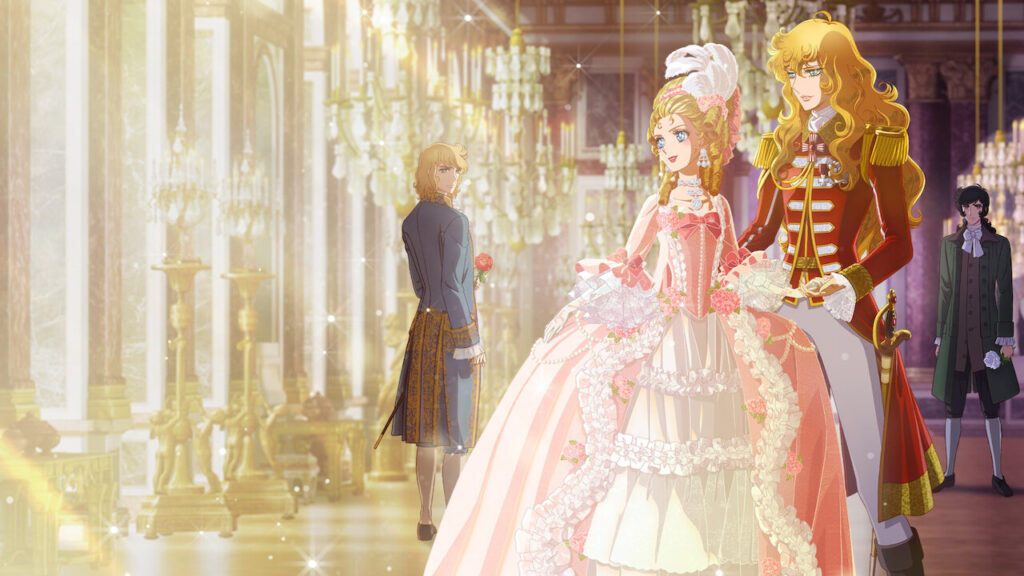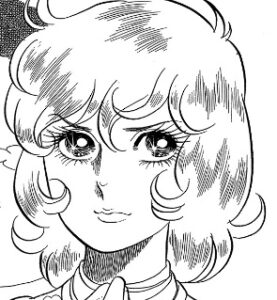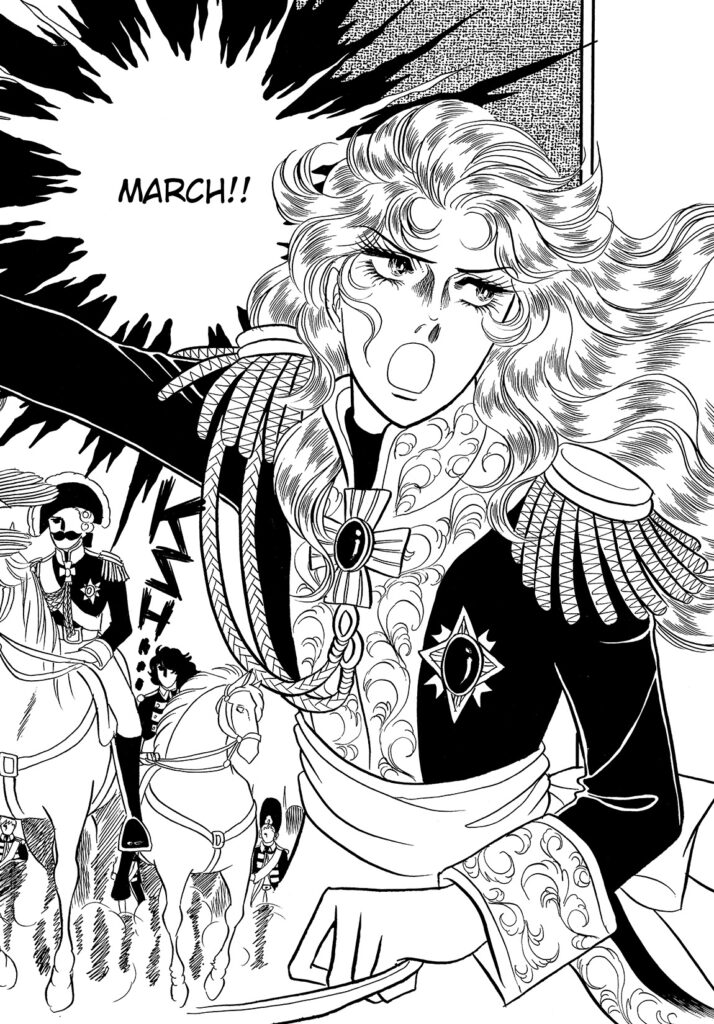 The Rose of Versailles movie, streaming on Netflix, is an ambitious, entertaining and colorful condensation of Riyoko Ikeda’s masterwork manga series set in the days leading up to the French Revolution.
The Rose of Versailles movie, streaming on Netflix, is an ambitious, entertaining and colorful condensation of Riyoko Ikeda’s masterwork manga series set in the days leading up to the French Revolution.
I was honored to be the editor for the English-language edition of The Rose of Versailles manga, published by Udon Entertainment. As a result, I am among a select few who can claim to have spent many intimate hours with the text of this magnum opus. I am no more intimate with the Dezaki anime than most other fans, having seen it two or three times (more on that later.) But the manga? I know that very well. ^_^
After opening credits that flash gilded splendor and brightly colored character designs in a dizzying display, we are flying above the carriage of Marie Antoinette as she, the new Dauphine, rides into Paris to the great acclaim of the French people. We are presented with a song of hope, that hunger and strife will be things of the past, now that their beautiful and beloved Antoinette arrives.
When then meet Oscar François de Jarjayes, the young scion of the noble de Jarjayes family. Born a girl, Oscar has been raised as a boy since her birth. She has been assigned the rank of Captain of the Queen’s Guard and is, likewise, acclaimed as beautiful and talented.
What follows is a tightly wound story, focusing on a mere four characters from this grand historical epic: Oscar, Marie Antoinette, Oscar’s servant Andre Grandier, and Hans Axel von Fersen, an envoy from Sweden. To quote from the very first panels of the manga itself, “1755… In this year, three individuals who would eventually have a fateful encounter at Versailles, France were born in three different European countries.”
The manga is a massive 1300+ page epic, spanning the years before and after the French Revolution, looking at this tumultuous time from the perspectives of noble and commoner alike, centering the experience of one person, Oscar, who moved between the classes through circumstance and choice and whose decisions come to rest on the side of the people.
The anime is a brilliant look at court life and the circumstances that turned the people against the Royal family.
This movie is about those three people mentioned in the first panels of the manga and the fourth, a loyal and loving servant carried in Oscar’s wake. To tell this more personal tale, much of the historical context is removed and some of the personal context is re-imagined as musical numbers. I really enjoyed these, noting that, of all four, only Oscar is ever seen “singing” any portion of the song. Animation during those musical numbers was grand in the way that Versailles is grand – over-produced and hard to watch, too much to take in. It was perfect.
While we’re on the topic of Versailles, this anime does the same thing the original anime does – it simplifies the visuals of Versailles. We see that it look fancy, but that is not how it looks at all. Versailles is entirely covered inside with marbles and porphyries and paintings so that there is nowhere for one’s eyes to rest. Every inch of floor and wall and ceiling is illustrated and gilded. This is important to understand, because as we see a young, presumably naive Marie Antoinette being besotted by clothes and watches and jewelry (and, in reality gambling), we must understand that Versailles is beyond normal people’s reckoning of how money is meant to spent. This is literally the kind of opulence the current US President aspires to, but as he is a short-fingered vulgarian, his vision is limited with no artistic aesthetic value, so his towers are classlessly gilded and tawdry. But I digress. My point is, that in the manga, we are meant to be exasperated with Marie Antoinette from the beginning, losing faith in her along with the French people and losing hope when when her own mother writes her to stop, already and remember her responsibility as well as her privilege. We are given leave to sympathize with her again at the very end of her life, as a mother who cares deeply for her children but, although she retains her dignity to the end, she also retains her unchanged belief in royalty’s claim of power granted by God, which makes her a hard person to like.
What this movie does well is frequently pay homage to both the manga from which it sprang and the original television anime series, directed by Dezaki Osamu, which led to his later masterwork direction on Dear Brother. We are frequently given moments from the anime, reimagined, and we once again meet old friends, who get a line or two: Rosalie, Bernard, Alain, Girodelle. Girodelle had 6 lines. I counted. I love Girodelle, in part for the fact that translation of his name is a key element in the presentations I was doing about translation and editing some years ago. Of the principle characters in the first half of the story, Girodelle is one of the few nobles who has no basis in history. So is ジェローデル Girodel or Girodelle? He only has one purple suit and I know how his story ends, which was a whole homage of it’s own. I won’t spoil the fun, though, in hopes that one day we finally do get the Rose of Versailles Episodes volume 1.
Homage to the manga comes in still screen shots (something Dezaki favors in his anime) that are rendered to look more like the manga, especially classic “shock eyes.” I know I mentioned this before, but while editing RoV, I collected a lovely assortment of Osca’rs expressions and eyes. So much of the story is told through the way she changes, from her youthful determination

to the moment she chooses her fate – her look of grief and despair cloaked in her desire to not waste her death.

Many of these looks are captured by this movie, something I really appreciated. The scene where Andre and Oscar spend the night together is also very reminiscent of the manga, to great effect.
Every time I watch this series to review it, it is so politically relevant I feel a bit nauseous. My first encounter with it was when Bush “nice-guyed” us into wars we did not belong in, and the second time, I finished the final disk just as police shot Michael Brown in Ferguson, Mississippi and again at the protests of that death, and this time I watched the movie as a petty and gobsmackingly incompetent man is funded by another petty and delusional man in order to destroy our Commons, so they can scrape more money out of our economy for their clothes, jewelry and gambling and the Mar-a-Petite Trianon. As prices rise and shelves start looking empty, I have to expect that we will be seeing scenes similar to those in this movie.
The voice acting was top-notch throughout, but I feel the need to praise Sawashiro Miyuki’s Oscar for a powerful performance throughout. She was outstanding in every scene, but the night before the storming of the Bastille, as she querulously ask if Andre would sleep with her, with a catch in her voice of fear and hope…breathtaking.
A number of people I respect felt that this movie was a superficial treatment of the story, I politely disagree. It chose a new path through this story, focusing not on events, or politics, or economics, but on the lives of four people who live through this history-changing event. And as that, I found it a fresh and approachable take on one of the greatest historical manga of all time.
Ratings:
Animation – 9 CGI was a little intrusive in some places, but the more over-the-top, the better it worked.
Characters – 9 We still get a sense of them
Story – 9 Of all the revolutions, the French Revolution never ceases to be relevant
Overall – 9
I understand why, when I stood on the spot formerly occupied by the Bastille, that there is no trace of the building. I wonder what our next revolution will pull down.
In happier thoughts, I am reminded of the time we visited the Margaret magazine 40th anniversary exhibition and were able to pose with Oscar and Andre, but the moment that really blew my head off, was coming around the corner to find myself facing the portrait of Oscar as Mars that, in the OG anime, she commissioned. There it was, lifesize in oils, and for a moment, reality bent and it was all real. ^_^
![]() Short report today, I’m on the road.
Short report today, I’m on the road.![]()


